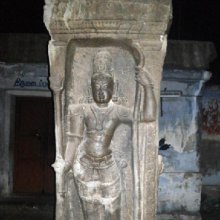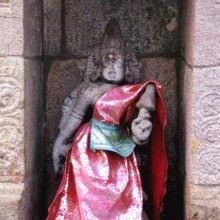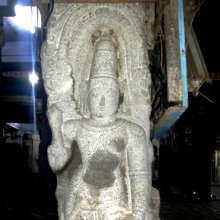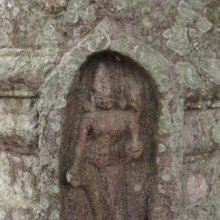Standing: 1 definition
Introduction:
Standing means something in Buddhism, Pali. If you want to know the exact meaning, history, etymology or English translation of this term then check out the descriptions on this page. Add your comment or reference to a book if you want to contribute to this summary article.
Images (photo gallery)
(+229 more images available)
In Buddhism
General definition (in Buddhism)
Source: A Buddhist Library: In This Very LifeStanding refers to one of the Traditional Four Postures (used in any type of meditation).—Suitable and appropriate activities can bring about insight knowledge. Seven types of suitability should be met in order to create an environment that is supportive of meditation practice. [...] The seventh and last kind of suitability is that of posture. [...] Beginning yogis should avoid the lying and the standing postures. The standing posture can bring about pain in a short while: tightness and pressure in the legs, which can disrupt the practice.
See also (Relevant definitions)
Starts with: Standing milk-vetch, Standing posture.
Ends with: Limited understanding, Understanding, Wrong understanding.
Full-text (+2231): Tatastha, Sthita, Kalaparivasa, Bhumistha, Uttha, Tishthat, Samapada, Utthana, Kritodvaha, Purushaka, Adhishthana, Standing posture, Khuntapra, Durastha, Sthanasana, Paryutthana, Samipattha, Atishthavan, Tatrastha, Dvarastha.
Relevant text
Search found 400 books and stories containing Standing; (plurals include: Standings). You can also click to the full overview containing English textual excerpts. Below are direct links for the most relevant articles:
Vinaya Pitaka (1): Bhikkhu-vibhanga (the analysis of Monks’ rules) (by I. B. Horner)
Vinaya Pitaka (3): Khandhaka (by I. B. Horner)
On the duties to the teacher < [1. Going forth (Pabbajjā)]
On release from dependence < [1. Going forth (Pabbajjā)]
The story of the ignorant and inexperienced < [1. Going forth (Pabbajjā)]
Practicing Insight on Your Own (by Acharn Thawee Baladhammo)
Standing - Walking Meditation < [Chapter 1]
The Second Step < [Chapter 1]
Vinaya Pitaka (2): Bhikkhuni-vibhanga (the analysis of Nun’ rules) (by I. B. Horner)
Manusmriti with the Commentary of Medhatithi (by Ganganatha Jha)
Verse 2.196 < [Section XXX - Rules to be observed by the Religious Student]
Verse 2.195 < [Section XXX - Rules to be observed by the Religious Student]
Verse 2.248 < [Section XXXI - Acquiring of Learning from the Lowest]
Vishnudharmottara Purana (Art and Architecture) (by Bhagyashree Sarma)
2.3. Standing Postures < [Chapter 3 - Drama and Dance]
1.3. Elements of Drama (d): Dramatic Postures < [Chapter 3 - Drama and Dance]
2. The Viṣṇudharmottara-purāṇa and the Indian Classical Dances < [Chapter 6 - Modern Relevance of Different Art Forms and Architecture]
Related products









